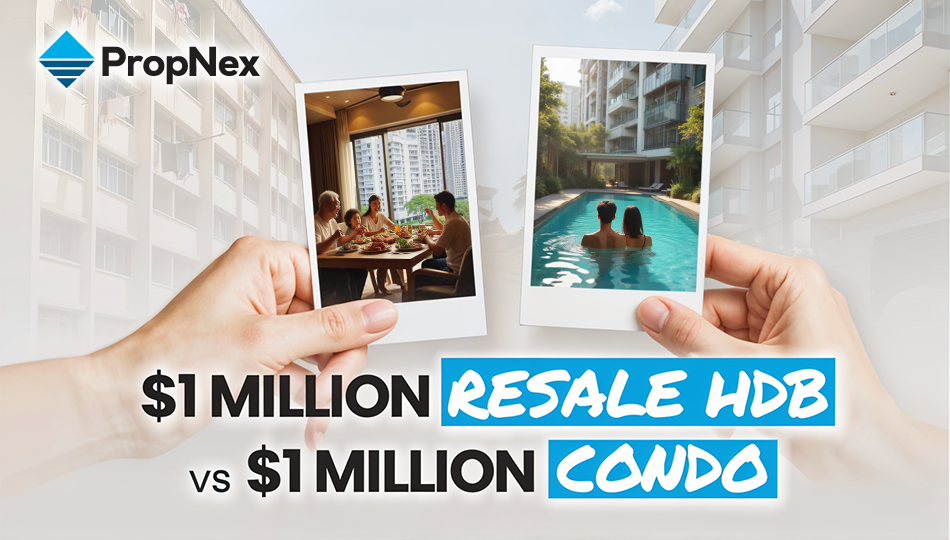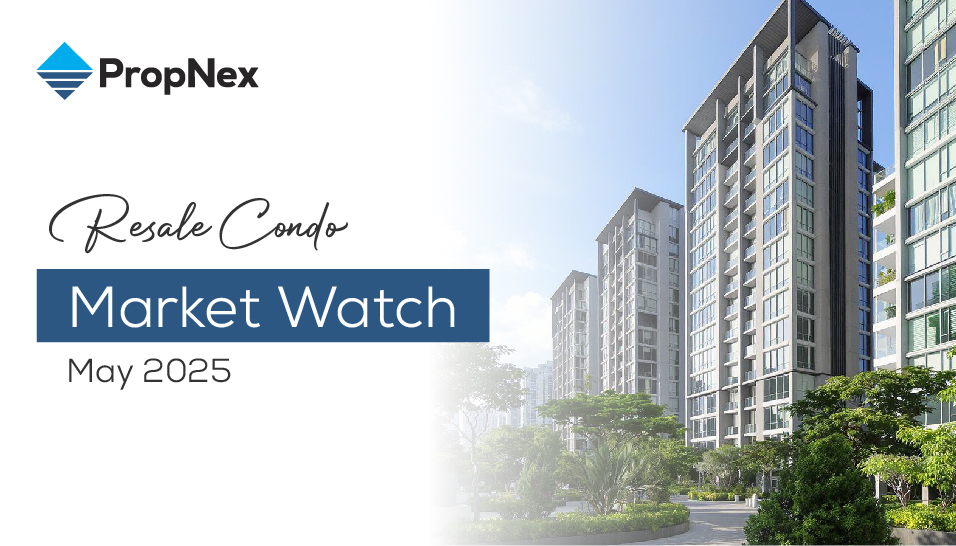PropNex Picks
|June 24,2025Smaller Home Bigger Prices: Are We Paying More For Less?
Share this article:
Singapore's property market is constantly evolving - with rising prices and shifting buyer preferences all reshaping the way we live. But one trend stands out more than ever: homes are shrinking.
Over the past few decades, both HDB flats and private condominiums have noticeably decreased in size. Some new launch units today barely offer enough room for a proper dining set, yet prices continue to climb. A 3-bedroom condo now is roughly the size of a 2-bedder from the 1990s, while older resale HDB flats are growing in appeal purely for one reason - space. So, why are we paying more for less? Is this driven by land scarcity, developer strategy, or changing lifestyle expectations? More importantly - is a compact home still a wise long-term investment?
Whether you're a first-time buyer or seasoned investor, understanding this trend is key. Let's break it all down.
It's not your imagination - homes in Singapore have gotten significantly smaller over the years. What used to be considered standard now feels tight, and spacious layouts from the past are increasingly rare.
HDB flat size trends over the years
HDBs have evolved over the years. They were once known for their generous layouts, built with growing families in mind. But as land became scarcer and urban planning focused on efficiency, unit sizes began to shrink.
Flat Type | 1980s Avg Size (sqm) | 2000s Avg. Size (sqm) | 2020s Avg. Size (sqm) |
3-room | 75 - 82 | 65 - 70 | 60 - 65 |
4-room | 105 - 110 | 90 - 95 | 85 - 90 |
5-room | 125 - 130 | 110 - 115 | 105 - 110 |
Executive | 145 - 150 | - | - |
HDB flats today are up to 20% smaller than those built in the 80s.
Executive flats, once the largest standard offering, have been discontinued since August 1995.
The four-room flat - the most common choice for families - has shrunk by about 15% over the decades.
Despite these reductions, HDB flats remain in high demand, especially in mature estates where older, larger units command a premium.
Private condo size trends over the years
The trend of shrinking homes isn't limited to public housing - private condominiums have also seen a sharp decline in unit sizes. Developers now optimise layouts to keep overall prices attractive, but this has led to significantly smaller homes.
Condo Type | 1990s Avg. Size (sqm) | 2010s Avg. Size (sqm) | 2020 Avg. Size (sqm) |
1-bedroom | 60 - 70 | 45 - 55 | 35 - 45 |
2-bedroom | 85 - 100 | 65 - 80 | 55 - 65 |
3-bedroom | 120 - 140 | 90 - 110 | 80 - 100 |
4-bedroom | 150 - 180 | 120 - 140 | 100 - 120 |
5-bedroom | 200 - 220 | 150 - 180 | 130 - 160 |
Modern 3-bedroom condos are now the size of older 2-bedroom units.
4-bedroom units have shrunk by 30% over the years, making them less common in new property developments, compared to smaller units. This is because developers often prioritise smaller units due to affordability and higher demand from decreasing household sizes.
5-bedroom units are not found in every project, with sizes much smaller than in the 90s.
The result? Buyers who want more space either pay a premium for older resale condos or compromise on location and opt for larger units in non-central districts.
You'd think smaller homes would mean lower prices. But in reality, the opposite has happened. While unit sizes have shrunk, property prices have surged - especially when measured by psf.
PSF: Then vs Now
Average PSF (Private Condo)
Back in the 1990s, you could buy a private condo at around $700-$800 psf. Today, new launches are regularly priced at $2,000-$2,700 psf, with luxury projects breaching even higher levels.
Let's say you bought a 1,200 sqft unit in the 90s for about $800,000. That same quantum today might only get you 800-900 sqft, depending on the location.
Buyers often debate whether new launch condos or resale units offer better value. Let's compare a new launch project vs an older resale condo in the same district.
Project | TOP | Unit Size (sqft) | Price (SGD) | PSF (SGD) |
The Shore Residences | 2014 | 1,292 | $2,660,000 | $2,059 |
Emerald of Katong | 2027 | 1,023 | $2,808,000 | $2,746 |
Newer condos have smaller unit sizes but significantly higher PSF.
A 3-bedroom resale unit from 2014 offers more space at a lower price compared to a smaller 3-bedroom in a recent launch.
Buyers pay more than 70% the PSF for a smaller unit in a newer project, making older resale units attractive for those prioritising space.
Want to compare real unit sizes and prices across both new launch and resale condos? With ProMap by PropNex, you can easily visualise and compare every available project across Singapore - from compact city-centre units to spacious resale gems in mature estates. It's your all-in-one map to make smarter, faster property decisions.
So, why are buyers still paying more?
Despite shrinking sizes and rising prices, new launch projects continue to sell out. Here's why:
The "affordable quantum" strategy: Developers reduce unit sizes so the overall price appears more attractive, even if the PSF is high. It's not about paying less overall, but about making the price feel more digestible.
Lifestyle over space: Many buyers today prioritise condo facilities, location, and convenience. New launches often come with modern layouts, smart home features, and resort-style facilities, making them appealing despite their smaller size.
Investment mindset: Some buyers view smaller units as better investments due to higher rental yield and lower total costs.
Singapore's shrinking home sizes are no accident - they are the result of government policies, developer strategies, and evolving buyer preferences. While some factors are a response to land scarcity and urban planning needs, others are deliberate moves by developers to maximise profits. At the same time, homebuyers are also adjusting their expectations, prioritising different aspects of homeownership.
But are Singaporeans really choosing smaller homes, or have we been nudged into this trend by larger forces?
Government regulations & land use constraints
Land in Singapore is a limited resource, and the government has always taken an active role in urban planning. As the city grows housing policies have been designed to optimise space, improve affordability, and accommodate a growing population. While these measures have ensured a steady housing supply, they have also contributed to shrinking home sizes over the years.
One of the biggest factors is plot ratio regulation. The URA determines how much gross floor area developers can build on a given plot of land. Higher plot ratios mean that more units can be built on the same amount of space, inevitably leading to smaller homes.
To curb the rise of ultra-small units, URA introduced the 85 sqm rule in 2018, requiring new condos outside the central region to have an average unit size of at least 85 sqm. While this was meant to limit excessive downsizing, developers adjusted their approach - instead of making individual units larger, they simply reduced the number of big units and increased the number of smaller ones, leading to today's compact three- and four-bedroom layouts.
HDB flats have also been affected by policy shifts. In the past, Executive Apartments and Maisonettes provided significantly more living space, but these were phased out in 1995 to ensure a more uniform housing supply and maintain affordability. It was also when the Executive Condominiums housing scheme was introduced. Today, HDB flats follow a more standardised size range, with layouts prioritising functionality over excess space. While these decisions have made public housing accessible to more Singaporeans, they have also reduced the availability of larger homes.
Developer strategies & profit maximisation
While government regulations set the framework, private developers have also played a major role in the shrinking home trends. With land prices at record highs, developers face immense pressure to maximise profits while keeping units attractive to buyers. One of the ways they do this is through affordable quantum pricing - instead of increasing price per square foot endlessly, they shrink unit sizes so that the total price remains "affordable" on paper. A 90 sqm three-bedroom unit priced at $1.8 million may seem more reasonable than a 120 sqm unit at $2.5 million, even though the latter offers better value.
Smaller units also allow developers to fit more units into each project, increasing the overall revenue potential of a given plot of land. In the 1990s, a typical condominium might have housed 300 larger units, but today, the same land parcel can accommodate 500 or more smaller units. This strategy benefits developers by increasing total sales volume while ensuring that individual units remain within an "affordable" range for buyers.
Ultimately, developers have found ways to navigate regulations while maximising profits, ensuring that smaller homes remain the standard rather than the exception.
Changing buyer preferences: Are Singaporeans choosing smaller homes?
Despite the shrinking unit sizes, new launch condos continue to sell incredibly well, suggesting that many buyers are adjusting to or even embracing this trend. One of the biggest reasons is a shift in priorities - many Singaporeans today prefer location, convenience, and lifestyle amenities over sheer space. Given the choice between a larger home in a less-central location and a compact unit in a prime district, many buyers are willing to trade size for accessibility.
This is especially true for younger professionals, who spend less time at home and value proximity to work and leisure options. With the rise of co-working spaces, some buyers also feel that they no longer need as much personal space at home. Instead, they prioritise developments with modern facilities, such as co-working lounges, rooftop gardens, and wellness zones, which add to their quality of life.
Private condo rental value of 1BR, 2BR, 3BR, 4BR, 5BR
1BR (Blue), 2BR (Red), 3BR (Orange), 4BR(Green), 5BR (Brown)
Investment is another driving factor. Many savvy homebuyers today view property not just as a place to live but as an asset for capital appreciation. Smaller units tend to have higher rental yields and are more affordable entry points for investors.
HDB rental value of 1R & 2R, 3R, 4R, 5R, Executive & Maisonettes
1R-2R (Blue), 3R (Red), 4R (Orange), 5R (Green), Executive & Maisonettes (Brown)
At the same time, declining family sizes have reduced the need for larger homes. Singapore's birth rate has been falling for years, and with more couples choosing to have fewer children (or none at all), the demand for spacious units has naturally declined. For many homebuyers today, a well-designed compact space feels sufficient for their lifestyle needs.
Birth rate over the years
Source: Department of Statistics Singapore
While some buyers still value space and refuse to compromise, the overall market has adapted to the new reality - where compact homes are the norm rather than the exception.
The big question: Will homes keep shrinking?
Looking ahead, it's unlikely that Singapore homes will return to the spacious layouts of the past. As long as land prices continue to rise, which it will, developers will keep optimising unit layouts to fit more homes into each project. Compact homes are here to stay, especially as younger generations prioritise affordability, location, and lifestyle over sheer space.
However, the market may reach a tipping point if home sizes become too small for comfort. If buyers begin resisting ultra-compact layouts, developers may be forced to adjust unit sizes to meet demand. Government policies could also play a role - if the authorities decide that homes are becoming too cramped, they may introduce new size regulations to ensure that future housing remains liveable.
For now, the trend is clear: smaller homes are the new normal, and buyers must adapt by choosing better layouts, smarter designs, and more functional spaces.
There's no denying it - Singapore homes are shrinking, yet prices keep rising. Whether it's an HDB flat or a private condo, today's buyers are definitely getting less space for their money compared to previous generations.
But is this necessarily a bad thing?
The answer depends on your goals. Today's compact homes reflect a shift in urban planning, buyer behaviour, and developer strategy. And while you may be paying more for less space, you're also gaining in other ways - better layouts, smart features, and access to amenities or central locations - green flags to look out for.
Ultimately, the real question isn't just "Am I paying more for less?" but rather, "Is this home still the right fit for my needs?" It's about how efficiently the space is designed, how well it supports your lifestyle, and whether it aligns with your financial and long-term goals.
Views expressed in this article belong to the writer(s) and do not reflect PropNex's position. No part of this content may be reproduced, distributed, transmitted, displayed, published, or broadcast in any form or by any means without the prior written consent of PropNex.
For permission to use, reproduce, or distribute any content, please contact the Corporate Communications department. PropNex reserves the right to modify or update this disclaimer at any time without prior notice.







